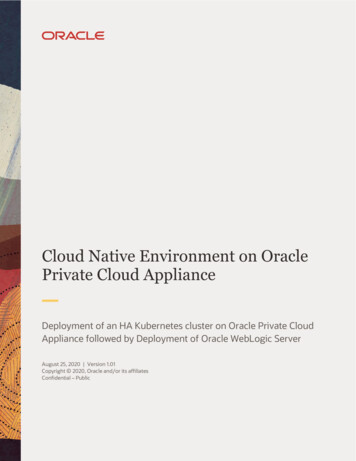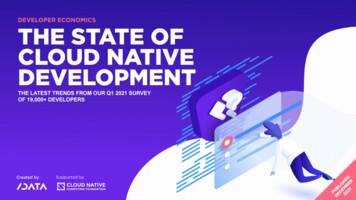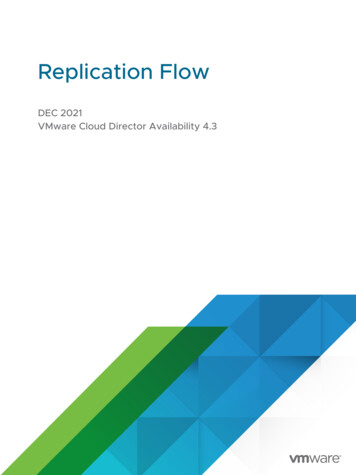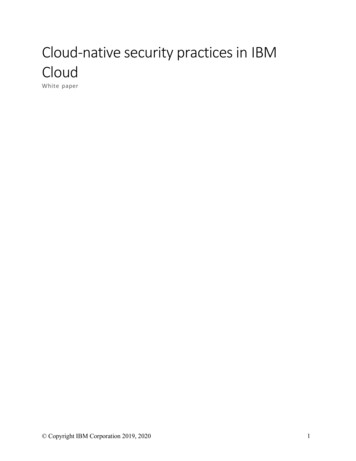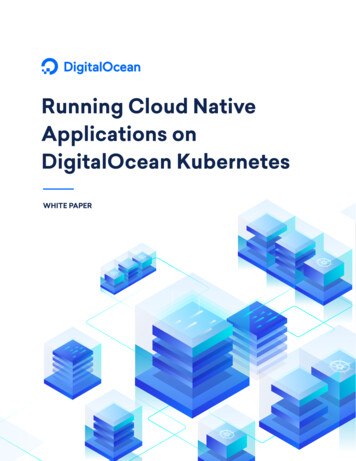
Transcription
Running Cloud NativeApplications onDigitalOcean KubernetesWHITE PAPER
Simplicity at ScaleDeveloper teams experiencing rapid growth and success know there areobstacles they must face when scaling to meet the demands of users. It canbe especially challenging to maintain performance and reliability whileengineering teams expand and users are rapidly acquired. Containerized,microservices-oriented applications that leverage the cloud’s extensiblefunctionality can support teams as they scale, mitigating the adversities thatarise from accelerated growth. However, Cloud Native delivery pipelinescome with their own challenges and require investments in DevOpsprocesses and systems that can often pose significant hurdles. In offering amanaged platform for running containerized applications, DigitalOceanKubernetes empowers development teams to spend less time worryingabout provisioning and operating cloud infrastructure and more timebuilding powerful, scalable, and resilient applications.
Executive Summary03Trends in Modern Application Development05Twelve FactorCloud NativeScaling with Kubernetes Case Study: The Snappy MonolithMicroservicesBreaking the Monolith: Snappy Microservices ArchitectureContainersBuilding a Snappy Microservice: Web UI Container netes Design OverviewDigitalOcean KubernetesCompleting the Shift to Cloud Native: Snappy on DigitalOcean KubernetesAbout DigitalOceanDigitalOcean is a cloud services platform delivering the simplicity developers loveand businesses trust to run production applications at scale. It provides highlyavailable, secure and scalable compute, storage and networking solutions that helpdevelopers build great software faster. Founded in 2012 with offices in New York andCambridge, MA, DigitalOcean offers transparent and affordable pricing, an elegantuser interface, and one of the largest libraries of open source resources available. Formore information, please visit digitalocean.com or follow @digitalocean on Twitter.202324
Executive SummaryIn today’s fast-moving software landscape, advances in operations technologies have fostered thedramatic reduction of application release cycles. Traditionally, software releases follow atime-based schedule, but it has become increasingly common to see applications and servicescontinuously delivered and deployed to users throughout the day. This truncating of the traditionalsoftware release cycle has its roots both in technological developments — such as the explosivegrowth of cloud platforms, containers, and microservices-oriented architectures — as well ascultural developments — with tech-savvy and mobile-enabled users increasingly expecting newfeatures, fast bug fixes, and a responsive and continuously developing product.This symbiotic relationship between end users and developers has become increasingly linked.Shifting organizational structures and application architectures allow developers to quicklyincorporate feedback and react to user demands. This accelerated development cadence oftenaccompanies the packaging of applications into containers, and the use of systems that automatetheir deployment and orchestration, like Docker Swarm, Marathon, and Kubernetes. Theseopen-source platforms, now stable enough for large-scale production deployments, allow serviceowners to launch and scale applications themselves, effortlessly managing hundreds ofrunning containers.Kubernetes and DigitalOcean KubernetesKubernetes, initially open-sourced by Google in 2014, has today grown to become one of thehighest velocity projects on GitHub, with over 11,300 contributing developers and 75,000 commits.1The growth of its thriving open-source community mirrors its popularity in the private sector, withover 50% of Fortune 100 companies relying on Kubernetes every day to rapidly deploy newfeatures and bug fixes to users.2DigitalOcean Kubernetes enables development teams both small and large to quickly takeadvantage of this market-leading container orchestration platform without the lead time required1 Cloud Native Computing Foundation. “Kubernetes Is First CNCF Project To Graduate.” Cloud NativeComputing Foundation Blog, Mar. 2018.2 RedMonk. “Cloud Native Technologies in the Fortune 100.” RedMonk Charting Stacks, Sept. 2017.RUNNING CLOUD NATIVE APPLICATIONS ON DIGITALOCEAN KUBERNETES03
to provision, install, and operate a cluster. With its simplicity and developer-friendly interfaces,DigitalOcean Kubernetes empowers developers to launch their containerized applications into amanaged, production-ready cluster without having to maintain and configure the underlyinginfrastructure. Seamlessly integrating with the rest of the DigitalOcean suite — including LoadBalancers, Firewalls, Object Storage Spaces, and Block Storage Volumes — and with built-insupport for public and private image registries like Docker Hub and Quay.io, developers can nowrun and scale container-based workloads with ease on the DigitalOcean platform.With full programmatic control of their cluster using the exposed Kubernetes REST API,developers can benefit from the rich ecosystem of open-source tools while still reaping theconvenience of managed infrastructure. Teams can flexibly deploy and scale their Cloud Nativeapplications. A Certified Kubernetes conformant platform, DigitalOcean Kubernetes helpsdevelopers launch their application containers and bring their Kubernetes workloads into theDigitalOcean cloud with minimal configuration and operations overhead.04
Trends in Modern Application DevelopmentAs Platform as a Service (PaaS) and Infrastructure as a Service (IaaS) offerings have matured,software development and architecture patterns have shifted to meet new infrastructureparadigms. Cloud providers abstract the underlying hardware away, and applications mustcorrespondingly be designed to handle failure and changes in this commodity computinginfrastructure. Exposing application endpoints to publish health and metric data (with theexpectation that these endpoints will be regularly polled and the data will be acted upon), as wellas packaging applications in smaller, self-contained disposable pieces has become the new normin developing resilient cloud-based applications.Designing applications that will be rapidly and continuously deployed into cloud environments hasled to the development of new software methodologies like “Cloud Native” and “Twelve Factor.”These high-level frameworks address common challenges in running scalable applications oncloud platforms and serve to guide software developers and architects in the design of resilientand highly observable applications. Such frameworks build on recent developments in softwareengineering like containers, microservices-oriented architectures, continuous integration anddeployment, and automated orchestration.Twelve FactorCodebaseSynthesizing extensive experience developing and deploying appsDependenciesonto their cloud PaaS, Heroku constructed a framework for buildingIII.Configmodern applications consisting of 12 development guidelines,IV.Backing servicesconceived to increase developers’ productivity and improve theV.Build, release, runmaintainability of applications.I.II.VI.ProcessesVII.Port bindingAs PaaS providers abstract away all layers beneath the application, itVIII.Concurrencyis important to adapt the packaging, monitoring, and scaling ofIX.Disposabilityapps to this new level of abstraction. The Twelve Factors allow aDev/prod paritymove towards declarative, self-contained, and disposable services.LogsWhen effectively leveraged, they form a unified methodology forAdmin processesbuilding and maintaining apps that are both scalable and easilyX.XI.XII.deployable, fully utilizing managed cloud infrastructure.RUNNING CLOUD NATIVE APPLICATIONS ON DIGITALOCEAN KUBERNETES05
Cloud NativeAs cloud platforms, infrastructure, and tooling have evolved and matured since the original TwelveFactors were published, and large-scale cloud migrations and deployments informed the softwaredevelopment community, an extended and broader methodology called Cloud Native hasemerged. At a high level, Cloud Native apps are containerized, segmented into microservices, andare designed to be dynamically deployed and efficiently run by orchestration systemslike Kubernetes.What makes an application Cloud Native?To effectively deploy, run, and manage Cloud Native apps, the application must implement severalCloud Native best practices. For example, a Cloud Native app should:Expose a health check endpoint so that container orchestration systems can probeapplication state and react accordinglyContinuously publish logging and telemetry data, to be stored and analyzed by systems likeElasticsearch and Prometheus for logs and metrics, respectivelyDegrade gracefully and cleanly handle failure so that orchestrators can recover by restartingor replacing it with a fresh copyNot require human intervention to start and runTo drive the adoption of Cloud Native best practices and support and promote the growing CloudNative Landscape, the Cloud Native Computing Foundation (CNCF) was created under theumbrella of the Linux Foundation to foster the growth and development of high-quality projectslike Kubernetes. Examples of other CNCF projects include Prometheus, a monitoring system andtime-series database often rolled out alongside Kubernetes; and FluentD, a data and log collectoroften used to implement distributed logging in large clusters.In its current charter, the CNCF defines three core properties that underpin CloudNative applications:Packaging applications into containers: “containerizing”Dynamic scheduling of these containers: “container orchestration”Software architectures that consist of several smaller loosely-coupled andindependently deployable services: “microservices”06
Scaling with Kubernetes Case Study:The Snappy MonolithTo demonstrate the value of implementing Cloud Native best practices including containerizationalong with a microservices architecture, we’ll use a running example throughout this paper: a photosharing app called Snappy that provides basic photo upload and sharing functionality betweenusers through a web interface.Throughout this paper, we’ll modernize Snappy by:Decomposing the app’s business functions into microservicesContainerizing the various components into portable and discretely deployable piecesUsing a DigitalOcean Kubernetes cluster to scale and continuously deploy thesestateless microservicesSNAPPY MONOLITHINTERNETAPI / WEB SINESSLOGICLOAD BALANCERDATABASE ADAPTERDB LAYERSNAPPY MONOLITHBINS / LIBS / LANGUAGE RUNTIMEOPERATING SYSTEMOBJECTSTORAGEDATABASEVIRTUAL SERVERRUNNING CLOUD NATIVE APPLICATIONS ON DIGITALOCEAN KUBERNETES07
With our photo-sharing monolith app Snappy, we observe that at first the web UI, photomanagement, and user management business functions are combined in a single codebase wherethese separate components invoke each other via function calls. This codebase is then built,tested, and deployed as a single unit, which can be scaled either horizontally or vertically.As Snappy acquires more users — and subsequently scales and iterates on the product — thecodebase gradually becomes extremely large and complex. Although code changes and bug fixesmay be minor, the entire monolith app needs to be rebuilt and re-deployed, forcing a sloweriteration cycle. Furthermore, if any individual subcomponent becomes a bottleneck in theapplication, the entire monolith must be scaled as a whole.MicroservicesMicroservices is a software architecture style that advocates for many granular services that eachperform a single business function. Each microservice is a self-contained, independentlydeployable piece of a larger application that interacts with other components, typically viawell-defined REST APIs.Microservices evolved as a hybrid of several software development trends and ideas. Some, likeService-Oriented Architectures (SOA), DevOps, and containerization are more recent, while others,like the Unix philosophy of “Do One Thing and Do It Well,” evoke principles developed decadesago. Initially pioneered by large, web-scale internet companies like Google, Amazon, and Netflix,microservices architectures have now become commonplace in applications of all sizes.08
Monolithic vs. Microservices ArchitecturesLarge, multi-tier software monoliths must be scaled as a cohesive whole, slowing downdevelopment cycles. In contrast, microservices provide several advantages over thisinflexible model:They can be scaled individually and on demandThey can be developed, built, tested and deployed independentlyEach service team can use its own set of tools and languages to implement features, andgrow at its own rateAny individual microservice can treat others as black boxes, motivating stronglycommunicated and well-defined contracts between service teamsEach microservice can use its own data store which frees teams from a single overarchingdatabase schemaBreaking the Monolith:Snappy Microservices ArchitectureLooking at Snappy through the lens of a microservices-oriented architecture, we see thatindividual business functions such as photo management and user administration have now beenbroken out into separate microservices that communicate via REST APIs. Each microservice canuse the data store most appropriate for the type of data it will be handling. For example, the photomanagement microservice can use a cloud object store for images along with a traditionalrelational database management system (RDBMS) for metadata. The service can then bedeveloped, tested, deployed, and scaled independently from other services. Allowing for greaterdevelopment agility, teams leveraging microservices can more efficiently use cloud infrastructure.RUNNING CLOUD NATIVE APPLICATIONS ON DIGITALOCEAN KUBERNETES09
INTERNETLOAD BALANCERWEB UIWEB UIREST APIREST APIWEB UI MICROSERVICELOAD BALANCERLOAD TREST APIREST APIREST APIREST APIREST APIOBJECTSTORAGERDBMSPHOTO MGMT MICROSERVICERDBMSUSER MGMT MICROSERVICE10
A microservices architecture lies at the heart of Cloud Native application development as theseapps consist of portable, containerized microservices that are scalable and disposable. Bybreaking up a monolithic application into many fine-grained, self-contained services — each ofwhich can be independently scaled, distributed across regions, and deployed across cloudplatforms — microservices enable faster development iteration, and increased flexibility in runningapplications on cloud infrastructure.ContainersThus far we’ve discussed high-level methodologies and architectures that underpin Cloud Nativeapplications. We’ll now discuss a core technology that allows developers to implement thesebroader architectural designs: containers.What are Containers?C ON TAI N E R I N STA N C EContainers are a way of packagingsnappy photo: 2.4snappy web: 1.0applications with all of their requireddependencies and libraries in a portable andB i n s /L i b sBi ns /L i b seasily deployable format. Once launched,these packages provide a consistent andC O N TA I N E R R U N T I M EH O ST O P E R AT I N G SYST E Mpredictable runtime environment for thecontainerized application. Taking advantageof Linux kernel isolation features such ascgroups and namespaces, containerI N FR AST R U C T U R Eimplementations — or runtimes — provide asandboxed and resource-controlled runningenvironment for applications.Containers vs. Virtual MachinesCompared to virtual machines, containers are more lightweight and require fewer resourcesbecause they encapsulate fewer layers of the operating system stack. Both provideresource-limited environments for applications and all their software dependencies to run, butsince containers share the host’s OS kernel and do not require separate operating systems, theyboot in a fraction of the time and are much smaller in size.RUNNING CLOUD NATIVE APPLICATIONS ON DIGITALOCEAN KUBERNETES11
Container RuntimesThough multiple container runtimes are available, Docker is the most mature, widely supported,and common format, embedded into most container orchestration systems. More recently, theOpen Container Initiative (OCI), a Linux Foundation project, has worked to standardize containerformats and runtimes, leading to the development and integration of lightweight and stableOCI-compliant runtimes such as containerd into orchestration systems. In mid-2018, TheKubernetes project announced general availability for the more minimal containerd runtime,embedding it into Kubernetes versions 1.10 and above.DOC KE RF I LEFROM.copyrunexposecmd.node: 10.2.1Build and Ship: Dockerizing an ApplicationContainerizing an application using Docker first involveswriting a container image manifest called a Dockerfile. This filepackage.json ./npm install8080[”npm”, “start”]describes how to build a container image by defining thestarting source image and then outlining the steps required toinstall any dependencies (such as the language runtime andlibraries), copy in the application code, and configure theenvironment of the resulting image.Developers or build servers then use the Docker container runtime to build these dependencies,libraries, and application sources into a binary package called a Docker image. Docker images arebuilt in ordered layers, are composable, and can be reused as bases for new images. Once built,these images can be used to start containers on any host with a Docker container runtime.Containers are central to running portable Cloud Native applications because using them naturallyguides development towards the implementation of several core Twelve Factor and Cloud Nativeprinciples. As needed, a given Docker container:Implements some narrow piece of business or support logicExplicitly declares all of its software dependencies in a DockerfileIs extremely portable across cloud providers as long as it has the requisite resources and aDocker runtimeDeploys quickly to replace a failed running container of the same typeReplicates easily to accommodate the additional load on a heavily requested businessfunction by launching additional container instances12
Once your team’s application has been neatly packaged into a set of microservice containers, eachperforming some unit of business functionality, you should consider the following questions:How do you then deploy and manage all of these running containers?How do these containers communicate with one another, and what happens if a givencontainer fails and becomes unresponsive?If one of your microservices begins experiencing heavy load, how do you scale the number ofrunning containers in response, assigning them to hosts with resources available?This is where Kubernetes and container orchestration come into play.Building a Snappy Microservice: Web UIContainer LifecycleTo demonstrate one possible container-based development workflow, we’ll zoom in on Snappy’sWeb UI microservice, an Express and Node.js based web server. / Develop & PushSince this Express app depends on Node.js and its related libraries to run, the snappy webDockerfile first sources a Node.js image from a Docker registry like Docker Hub. Further Dockerfilesteps include app configuration, copying in source code files, and finally telling Docker whichcommand to run when launching the application container.13
A Snappy developer on the web UI team begins work on a small UI bug fix. The developer tests codechanges locally by rebuilding the Express Docker image and running the web server container ontheir laptop. The developer, satisfied with the changes, then pushes the code to a branch in theteam’s source code repository.Build & TestThis push triggers a continuous integration pipeline build. The continuous integration server buildsthe Node.js dependencies, libraries, and modified sources into a Docker image. Once built, thepipeline runs this image as a container and proceeds to execute unit and integration tests.If all the tests pass, this validated Docker image is then pushed to a container image registry — anabstraction layer typically built on top of object storage — for container image tagging, organization,and efficient reuse of existing image layers. Private, organization-specific container image registriesallow teams to share and publish images to a central, secure location, whereas public registries allowpopular open-source projects like Node.js to make the latest versions of their software available todevelopers in prebuilt container image form.Deploy & RunNow that the Snappy web UI container image containing the bug fix has been approved and pushedto a registry, a container orchestration system such as Kubernetes can then “pull” this image anddeploy it onto any host with a Docker runtime. This running container is given a narrow view ofavailable resources specified by the developer, and is run in isolation from other containers. A singlehost with a container runtime installed can run several containers simultaneously, depending onavailable resources.RUNNING CLOUD NATIVE APPLICATIONS ON DIGITALOCEAN KUBERNETES14
DO C K E R FI L EDE VFROM.copyrunexposecmd.PUS HCODETR IGGERB UIL DC I/C Dnode: 10.2.1package.json ./npm install8080[”npm”, “start”]VER S IO NC O N TR O LR EPO S ITO RYB UIL DTE STSOURCECODE / PUS H IMAGEsnappy web: 1.0D E PLOY IMAGEsnappy web: 1.0snappy photo: 2.4snappy web: 1.0snappy photo: 2.3snappy web: 0.9snappy photo: 2.2snappy web: 0.8.IM AGE R EGISTRYsnappy photo: 2.4snappy web: 1.0B in s /L i b sBi ns /L i b sC ON TAI N E RC O N TA I N E R R U N T I M EH O ST O P E R AT I N G SYST E MI N FR AST R U C T U R EK U BE R N E T ES N O D EKU B E RN E T E S C LU ST E R15
ClustersAdopting a microservices architecture consisting of containerized applications paves the way formore efficient use of infrastructure, close control of application runtime environments, and theability to automatically scale. However, one of the major tradeoffs in moving to amicroservices-oriented architecture are the added complexities (e.g. in business logic,observability, and incident management) in managing a constantly evolving distributed system.Container orchestration systems were designed to reduce some of the operations overhead byabstracting away the underlying infrastructure and automating the deployment and scaling ofcontainerized applications. Systems such as Kubernetes, Marathon and Apache Mesos, and Swarmsimplify the task of deploying and managing fleets of running containers by implementing some orall of the following core functionality:Container SchedulingHealth Checking and State ManagementLoad BalancingAutoscalingService DiscoveryRolling DeploymentsCluster NetworkingDeclarative ConfigurationLet’s briefly take a look at each of these features:Container SchedulingWhen deploying a container or sets of identical containers, a scheduler manages allocating thedesired resources (like CPU and memory) and assigns the containers to cluster member nodeswith these resources available. In addition, a scheduler may implement more advancedfunctionality like container prioritization, as well as balancing out sets of identical containers acrossdifferent members and regions for high availability.RUNNING CLOUD NATIVE APPLICATIONS ON DIGITALOCEAN KUBERNETES16
Load BalancingOnce deployed into a cluster, sets of running containers need some load balancing component tomanage the distribution of requests from both internal and external sources. This can beaccomplished using a combination of cloud provider load balancers, as well as load balancersinternal to the container orchestration system.Service DiscoveryRunning containers and applications need some way of finding other apps deployed to the cluster.Service discovery exposes apps to one another and external clients in a clean and organizedfashion using either DNS or some other mechanism, such as local environment variables.Cluster NetworkingClusters also need to connect running applications and containers to one another acrossmachines, managing IP addresses and assignment of network addresses to cluster members andcontainers. Networking implementations vary across container cluster projects; some like DockerSwarm bake a set of networking features directly into the cluster, whereas others like Kubernetesimpose a minimal set of requirements for any networking implementation, allowing administratorsto roll out their own custom overlay network solution.Health Checking and State ManagementA core feature implemented by Cloud Native applications is health reporting, usually via a RESTendpoint. This allows orchestrators to reliably check the state of running applications and only directtraffic towards those that are healthy. Also using this endpoint, orchestrators repeatedly proberunning apps and containers for “liveness” and self-heal by restarting those that are unresponsive.17
AutoscalingAs load increases on a given application, more containers should be deployed to match thisgrowth in demand. Container orchestrators handle scaling applications by monitoring standardmetrics such as CPU or memory use, as well as user-defined telemetry data. The orchestrator thenincreases or decreases the number of running containers accordingly. Some orchestration systemsalso provide features for scaling the cluster and adding additional cluster members should thenumber of scheduled containers exceed the amount of available resources. These systems canalso monitor utilization of these members and scale the cluster down accordingly, reschedulingrunning containers onto other cluster members.Rolling DeploymentsContainer orchestration systems also implement functionality to perform zero-downtime deploys.Systems can roll out a newer version of an application container incrementally, deploying acontainer at a time, monitoring its health using the probing features described above, and thenkilling the old one. They also can perform blue-green deploys, where two versions of theapplication run simultaneously and traffic is cut over to the new version once it has stabilized. Thisalso allows for quick and painless rollbacks, as well as pausing and resuming deployments as theyare carried out.Declarative ConfigurationAnother core feature of some container orchestration systems is deployment via declarativeconfiguration files. The user “declares” which desired state they would like for a given application(for example, four running containers of an NGINX web server), and the system takes care ofachieving that state by launching containers on the appropriate members, or killing runningcontainers. This declarative model enables the review, testing, and version control of deploymentand infrastructure changes. In addition, rolling back applications version can be as simple asdeploying the previous configuration file. In contrast, imperative configuration requires developersRUNNING CLOUD NATIVE APPLICATIONS ON DIGITALOCEAN KUBERNETES18
to explicitly define and manually execute a series of actions to bring about the desired clusterstate, which can be error-prone, making rollbacks difficult.Depending on the container orchestration project, some of these features may be implementedwith more or less maturity and granularity. Whether it’s Apache’s Mesos and Marathon, Docker’sSwarm, or Kubernetes, a container orchestration system greatly facilitates running scalable andresilient microservices on cloud platforms by abstracting away the underlying infrastructure andreducing operational complexity.Rolling out cluster software to manage your applications often comes with the cost ofprovisioning, configuring, and maintaining the cluster. Managed container services likeDigitalOcean Kubernetes can minimize this cost by operating the cluster Control Plane andsimplifying common cluster administration tasks like scaling machines and performingcluster-wide upgrades.As open-source container clusters and their managed equivalents have evolved and graduallytaken on large-scale production workloads, Kubernetes and its expanding ecosystem of CloudNative projects have become the platform of choice for managing and scheduling containers. Byimplementing all of the features described above, Kubernetes empowers developers to scalealongside their success, and managed Kubernetes offerings provide them with even greaterflexibility while minimizing DevOps administration time and software operations costs.KubernetesThe Kubernetes container orchestration system was born and initially designed at Google byseveral engineers who architected and developed Google’s internal cluster manager Borg. Theseengineers sought to build and open-source a container management system that integrated manyof the lessons learned from developing this internal container platform. Since its July 2015 v1.0release, Kubernetes has rapidly matured and been rolled out in large production deployments byorganizations such as Bloomberg, Uber, eBay, and also here at DigitalOcean. In March 2018,Kubernetes became the first project to graduate from the Cloud Native Computing Foundation,indicating that it has become mature and stable enough to handle large-scale productiondeployments and has achieved a high level of code quality and security.19
Beyond implementing all of the container cluster features listed above (and many more),Kubernetes benefits from a thriving open-source community, which actively develops new featuresand provides constant feedback and bug reporting across a variety of deployments and use cases.In addition to Kubernetes features, this growing developer community continuously builds toolsthat simplify the process of setting up, configuring, and managing Kubernetes clusters.Before discussing DigitalOcean Kubernetes and how it enables developers to rapidly deploy theircontainerized Cloud Native applications into a manage
building powerful, scalable, and resilient applications. Executive Summary Trends in Modern Application Development Twelve Factor Cloud Native . Microservices is a software architecture style that advocates for many granular services that each perform a single business function. Each microservice is a self-contained, independently

